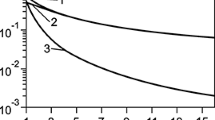Abstract
A method for the design of a second-order recursive filter, optimal in terms of the bias error, and a method for the synthesis of the parameters of correlation filter spectrum analyzers based on it are presented. The improvement of technical characteristics of spectrum analyzers based on dynamic filters is obtained by the transition from analog to digital filtering. The structure of the recursive narrowband digital dynamic filter of the second order is optimized by the minimum relative dispersion of the power spectral density estimation. It is justified that the correlation-filter spectrum analyzer has two components of methodological error: approximation error and statistical error. Expressions for the relative approximation error of the power spectral density estimate for two versions of optimization respectively with the constant and piecewise-step law of change of the relative attenuation coefficient of the proposed second-order digital dynamic filter are derived. The results of experimental studies suggest that the spectrum analyzer based on the proposed recursive filter of the second order provides considerably higher accuracy (of the order of several percent) in comparison with classical filter analyzers with stationary non-reconfigurable filters of even higher-order (third and fourth). The advantages in the accuracy of digital correlation-filter spectrum analyzers with the use of a narrow-band digital dynamic filter of the second order are demonstrated. The theoretical and practical principles of their design are presented.










Similar content being viewed by others
Data Availability Statement
The datasets generated during and/or analyzed during the current study are available from the corresponding author on reasonable request.
References
Bhanu SJ, Baswaraj D, Bigul SD, Sastry JKR (2019) Generating test cases for testing embedded systems using combinatorial techniques and neural networks based learning model. Int J Emerg Trends Eng Res 7(7):417–429. https://doi.org/10.30534/ijeter/2019/047112019
Bonavolontà F, D’Apuzzo M, Liccardo A, Mieleb G (2016) Harmonic and interharmonic measurements through a compressed sampling approach. Measurement 77:1–15. https://doi.org/10.1016/j.measurement.2015.08.022
Chinkov VM, Gerasimov SV (2013) Study and justification of the criteria of optimization of measurement signals for automated control systems. Ukrainian Metrol J 4:43–47. http://www.metrology.kharkov.ua/fileadmin/user_upload/data_gc/umj/2013/umj_2013_4/JRN/PDF/2.pdf
Dudnik PI, Ilchuk AR, Tatarskii BG (2007) Multifunctional radar systems: textbook for universities. Ed. B.G. Tatarskii. Moscow. Drofa
Hajimolahoseini H, Taban MR, Soltanian-Zadeh H (2012) Extended Kalman Filter frequency tracker for nonstationary harmonic signals. Measurement 45:126–132. https://doi.org/10.1016/j.measurement.2011.09.008
Helstrom CW (1995) Elements of signal detection and estimation. Prentice Hall, Englewood Cliffs. NJ. USA
Herasimov S, Belevshchuk Y, Ryapolov I, Tymochko O, Pavlenko M, Dmitriiev O, Zhyvytskyi M, Goncharenko N (2018) Characteristics of radiolocation scattering of the SU-25T attack aircraft model at different wavelength ranges. Inf Control Syst. East Euro J Entrep Technol. 6(96):22–29
Herasimov S, Pavlii V, Tymoshchuk O et al (2019) Testing signals for electronics: Criteria for synthesis. J Electron Test 35(148):1–9. https://doi.org/10.1007/s10836-019-05798-9
Herasimov S, Roshchupkin E, Kutsenko V, Riazantsev S, Nastishin Yu (2020) Statistical analysis of harmonic signals for testing of Electronic Devices. Int J Emerg Trends Eng Res. 8(7):3791–3798. https://doi.org/10.30534/ijeter/2020/143872020
Herasimov S, Tymochko O, Kolomiitsev O, Aloshin G, Kriukov O, Morozov O, Aleksiyev V (2019) Formation analysis of multi-frequency signals of laser information measuring system. EUREKA Phys Eng 5:19–28. https://doi.org/10.21303/2461-4262.2019.00984
Karimian-Azari S, Jensen JR, Christensen MG (2016) Computationally efficient and noise robust DOA and pitch estimation. Proc IEEE/ACM Trans Audio Lang Process 24:1613–1625. https://doi.org/10.1109/TASLP.2016.2577501
Kihong S (2019) On the selection of sensor locations for the fictitious FRF based fault detection method. Int J Emerg Trends Eng Res 7(7):569–575. https://doi.org/10.30534/ijeter/2019/277112019
Levanon N, Mozeson E (2004) Radar signals. John Wiley & Sons Inc, Hoboken NJ
Murphy E, Colm S (2004) All about direct digital synthesis. Analog Dialogue 8(3):1–5. https://www.analog.com/en/analog-dialogue/articles/all-about-direct-digital-synthesis.html
Rybin Yu (2014) Measuring signal generators. Springer, Theory and Design. New York
Spatial-temporal Signal Processing (1984) Ed. I. Kremer. Moscow. Radio and Communication
Wu X, Tian Z, Davidson T, Giannakis G (2006) Optimal waveform design for UWB radios. IEEE Trans Signal Process 54(6):2009-2021. https://www.ece.mcmaster.ca/~davidson/pubs/Wu_etal_UWB_waveform_design.pdf
Author information
Authors and Affiliations
Corresponding author
Ethics declarations
Conflicts of Interest
The authors have no conflicts of interest to declare that are relevant to the content of this article.
Additional information
Communicated by M. Margala
Publisher's Note
Springer Nature remains neutral with regard to jurisdictional claims in published maps and institutional affiliations.
Rights and permissions
About this article
Cite this article
Herasimov, S., Borysenko, M., Roshchupkin, E. et al. Spectrum Analyzer Based on a Dynamic Filter. J Electron Test 37, 357–368 (2021). https://doi.org/10.1007/s10836-021-05954-0
Received:
Accepted:
Published:
Issue Date:
DOI: https://doi.org/10.1007/s10836-021-05954-0




